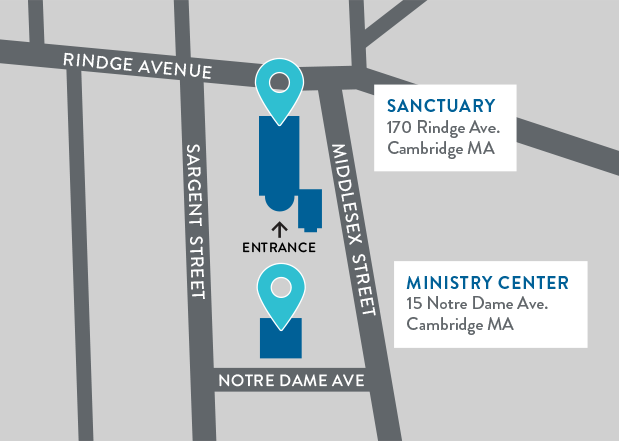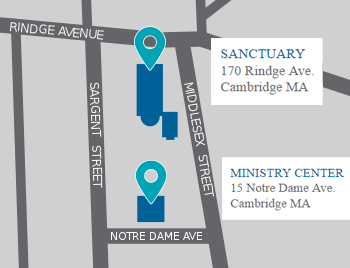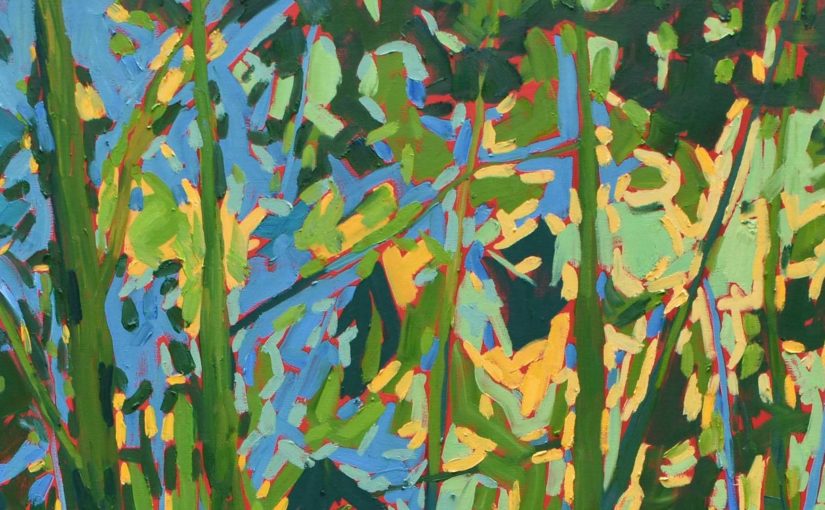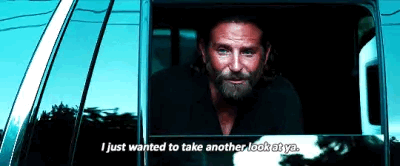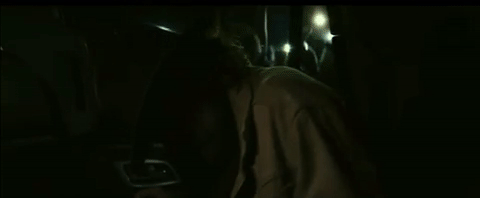Jillie Wowk-Kennedy, Reservoir Member, interviews Raymond Paradiso, whose work is currently on display in the Reservoir Dome Gallery. Ray is a Massachusetts-based oil painter. See his art through February 28 before/during/after our Sunday services.
Something I discovered is that, if you stare long enough, Ray Paradiso’s paintings will lift off in layers, rewarding your patience with the knowledge that there are pure magenta skies under his stained glass trees. Next time you’re in the Dome Gallery at Reservoir, treat yourself to a few moments of meditation in front of one of his vibrant canvasses and tell me if you can’t feel the sun warm your face. Maybe when you turn back to the midwinter weather we’ve been “enjoying,” shadows of his landscapes will linger like those Magic Eye pictures and you can carry a little bit of that late summer sun into the cold.
How did you first develop your appreciation for oil painting?
When I first started painting about 12 years ago I was using acrylics because of the easier clean up and use of water for medium, and also because they dried very fast and I could re-paint and fix paintings more easily as I went along. As I got more into painting, a well-known artist who I had the privilege of working with encouraged me to try oils because of the vivid colors. Once I started using oils and got the hang of them, I never went back. I don’t see myself going back to acrylic, but would like to try some other techniques, like the use of wax or other interesting mediums and materials.
How long have you been painting?
I was into art and did some painting throughout elementary school and high school, but then gave it up completely after I started college and pursued a career in high tech and had a family. About 12 years ago I started dabbling with watercolors and acrylics; I fell in love with painting and did it part time in the evenings or weekends, when I wasn’t working my day job. I took some courses in the area and then I was lucky enough to be able to paint with some fine teachers who really helped me with my art.
What is something oil lets you do that other forms of paint just can’t?
It’s been a while since I used acrylics, but oil has a unique feel. The colors are just different; I suppose they are more vivid. They just flow differently.
What’s a lesson painting has taught you?
The more I paint, the more I find the process of painting to be a metaphor for so many other things I do in life. I’m a type A person, so I find that I need to constantly be aware of having patience, not rushing, and being in the present. While painting, you can look at what you have done at a certain point and then step away for even 10 minutes and come back and the painting can look different. Again, something to be thought about in life.
If you could direct your viewers’ eyes to one thing in your work, what would it be?
It would be easy to say notice my thick brush strokes, or the unusual combination of colors, but I would rather let viewers view my paintings organically and see and appreciate what stands out to them. Some might see a familiar landscape that they have visited (like the desert southwest) and some might see a colorful arrangement of shapes and colors. I find that the more abstract I get, the more is left to the viewer to see and I enjoy hearing from them about what they see or what they like in one of my paintings.
Do you have a favorite piece? One that you’re most proud of or was the most fun to create?
These days I paint quite a bit and turn out about 1 painting a week on average, so I don’t think I have one favorite painting. Sometimes the paintings I’m most happy with are not necessarily the ones that come out the best (in my opinion), but rather are the ones where the process from beginning to end was smooth, or to use a cliché, the ones where I was in the “zone” most of the time. These paintings are usually the ones that I don’t overdo and get to where I want them to be with the least gnashing of teeth.
I follow my instincts and in that process, am breaking rules all the time
What is one tool you can’t live without?
So far I’m pretty traditional with tools. I paint in oils on stretched canvas. I use a variety of brushes and am starting to use palette knives, but that is it. I read a lot and watch YouTube videos of artists who use an amazing variety of tools and methods like sticks, squeegees, their hands and other body parts, you name it. I hope to eventually start to look at waxes and other mediums, but for now my brushes are my main tools.
What is a rule you love to break?
My paintings are mostly impressionistic and I’m starting to incorporate more abstraction into my work. I continue to break the traditional rules of landscape and am more concerned with shapes, light, and interesting combinations of colors. So, I don’t think there is one rule I break, but I follow my instincts and in that process, am breaking rules all the time.
Every artist has their own pace and practice. You say you don’t exactly start each piece with a preconceived notion of the end result, so how do these pieces reveal themselves to you? How do you know you’re on the right track?
Some paintings are easy from start to finish, but most are roller coaster rides. There will be times during the process where I like the way things are going and [other] times when I think the painting is a disaster and I start having thoughts like time to trash this one. But over time I have learned to slow down and not panic and maybe stop and see what things look like the next day. Because oils dry slowly, I have also started to occasionally scrape and wipe off a section of a painting that I feel is all wrong (in color or value or composition) and this allows me to go back and redo that section without it getting too messy, or muddy, which can happen if you just keep adding paint to the same area. So, the paintings reveal themselves to me in different ways over and over again and sometimes surprise me with where they are going. If I can trust that phenomena and go with it, things sometimes come out pretty cool.
What are some pieces of Art that you’ve been enjoying or return to for inspiration or rest?
I almost always listen to music while I am painting. Everything from jazz to rock to classical. Often I find there is a kind of synergy going on between the music and what I am painting. I can’t really explain it. It happens most often with jazz, and I often title my paintings after the song titles I might have been listening to while I was painting a particular piece.
What’s your dream project? (No time constraints, money is no object, etc. etc.)
I’m pretty much doing what I really want to do now with my art. I don’t have any big plans or dreams to say spend a summer in Tuscany painting the landscape (but if offered I wouldn’t turn it down!). I don’t have one particular project in mind but there will always be so much to learn, so much to experiment with, and so many things to try that I just hope I can continue to allocate the time and energy and perseverance to keep at it and continue to experiment and learn.
In troubled times, Fred Rogers says to look for the helpers. Who are your helpers?
My helpers are my wife and kids and a few good friends. Whether it’s giving me encouragement, or helping to transport and set up paintings for an art show, they are my helpers.
Is there a question I haven’t asked that you wish I did?
Nothing specific, but I want to say I am very lucky to have found this endeavor that I love and am passionate about and have had the privilege of meeting and studying with some fine teachers.
_______
Well, not to sound extremely hokey, but I’m thankful for Raymond’s family, friends, and teachers, too. I love that he came back to his work after his life was already firmly on another track. There’s a Jurassic Park quote for every occasion and for this one it’s this: “Life finds a way.” I hope Raymond’s example will lead to many more people picking back up the passions of their youth, because, if you take a look at Bramble or (my personal favorite) Veridian Thicket, extraordinary things come of it. Thanks, Ray!
